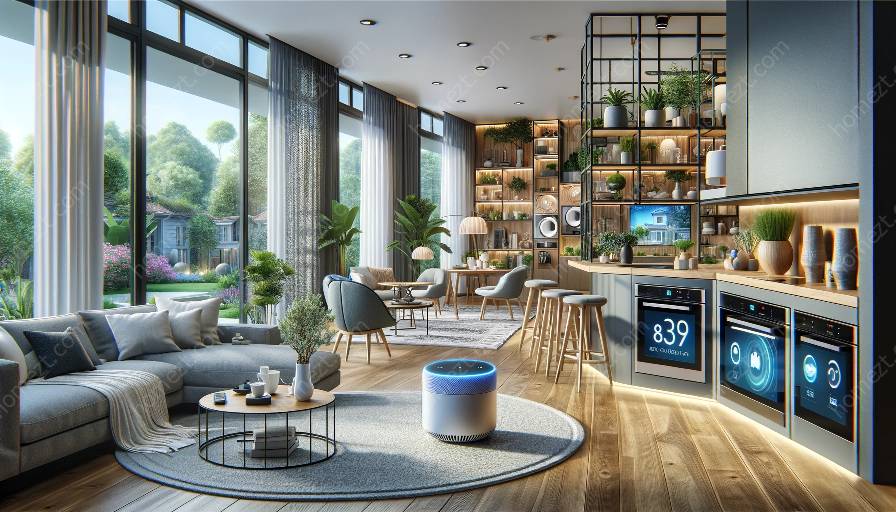In today's fast-paced world, the concept of an intelligent home is becoming increasingly popular. Homeowners are seeking ways to incorporate innovative technologies into their living spaces to simplify everyday tasks and enhance convenience. One such groundbreaking innovation is the use of voice-controlled home appliances, which can be seamlessly integrated into an intelligent home design. In this article, we will explore the process of building voice-controlled home appliances using Raspberry Pi, a versatile and affordable microcomputer that opens up a world of possibilities for home automation.
Understanding Voice-Controlled Home Appliances
Voice-controlled home appliances utilize speech recognition technology to interpret spoken commands and trigger specific actions. This technology has gained traction due to its intuitive and hands-free nature, allowing users to effortlessly control various devices and systems within their homes. By integrating voice control into home appliances, individuals can streamline their daily routines, improve accessibility for individuals with disabilities, and create a more interactive and responsive living environment.
With the rapid advancements in artificial intelligence and natural language processing, voice-controlled home appliances have evolved to offer advanced functionalities, such as personalized voice recognition, contextual understanding, and seamless integration with other smart devices. As a result, homeowners can enjoy a truly intelligent and interconnected home ecosystem that caters to their unique preferences and needs.
Introduction to Raspberry Pi
Raspberry Pi is a small, affordable, and highly versatile computer that is designed to facilitate learning, experimentation, and prototyping in the field of computer science and electronics. Originally conceived as an educational tool to promote computer literacy and programming skills, Raspberry Pi has transcended its initial purpose and found applications in diverse domains, including home automation, robotics, and IoT (Internet of Things).
Equipped with various input/output ports, Wi-Fi connectivity, and a range of software options, Raspberry Pi serves as an ideal platform for building voice-controlled home appliances. Its compact size and low power consumption make it well-suited for embedding within household devices, thereby allowing for seamless integration of voice control capabilities without incurring significant hardware costs.
Creating Voice-Controlled Solutions with Raspberry Pi
Building voice-controlled home appliances using Raspberry Pi involves several key steps, each of which contributes to the overall functionality and user experience of the final product. The following outline provides an overview of the process:
- Identifying Appliance(s) and Desired Functions: Begin by selecting the appliance(s) you wish to make voice-controlled and defining the specific commands or actions to be associated with each device. Consider the practicality, safety, and utility of implementing voice control for each appliance.
- Setting Up Raspberry Pi: Acquire a Raspberry Pi board along with essential peripherals such as a microSD card, power supply, and optional accessories. Install the preferred operating system (e.g., Raspbian) and configure the necessary software components for voice recognition and appliance interaction.
- Integrating Voice Recognition Software: Select and implement a suitable voice recognition software or service, such as Google Assistant SDK, Amazon Alexa, or custom-built solutions based on open-source libraries (e.g., CMU Sphinx). Establish the required communication protocols between Raspberry Pi and the voice recognition service.
- Connecting and Controlling Appliances: Establish the physical and logical connections between Raspberry Pi and the target appliances, ensuring compatibility with the interface and control signals. Depending on the complexity of the appliances, additional hardware interfaces (e.g., relays, sensors) or custom circuitry may be required.
- Developing User Interfaces (Optional): Design and implement supplementary user interfaces, such as mobile applications or web-based dashboards, to provide alternative means of appliance control and interaction. Ensure seamless synchronization and synchronization with voice commands.
- Testing and Refinement: Thoroughly test the voice-controlled appliances under various scenarios and user conditions to identify and address any performance or interoperability issues. Gather feedback from potential users and iterate on the design to enhance user satisfaction and usability.
Integrating Voice-Controlled Appliances into an Intelligent Home Design
Upon successfully building and deploying voice-controlled home appliances using Raspberry Pi, the next step is to integrate these devices into a broader intelligent home design. This entails creating synergistic relationships between various smart devices, sensors, and automation systems to deliver a cohesive and harmonious living experience.
For instance, voice-controlled lighting, thermostats, entertainment systems, and security devices can be orchestrated to respond intelligently to user commands, environmental conditions, and predetermined schedules. By leveraging the capabilities of home automation platforms (e.g., Home Assistant, OpenHAB), homeowners can craft intricate automation routines and personalized settings that cater to their lifestyle and preferences.
Future Prospects and Considerations
As the field of voice-controlled home appliances continues to evolve, it is poised to witness further advancements in areas such as machine learning, voice synthesis, and natural language understanding. Additionally, the integration of voice assistants, cloud services, and IoT ecosystems will contribute to the seamless interoperability and expanded functionality of voice-controlled systems.
When incorporating voice-controlled home appliances into an intelligent home design, it is crucial to address considerations related to privacy, security, and data management. Implementing robust encryption, user authentication mechanisms, and data protection measures will safeguard the integrity and confidentiality of voice interactions within the home environment.
Conclusion
By harnessing the capabilities of Raspberry Pi and embracing the potential of voice-controlled technology, homeowners can embark on a journey of innovation and customization in home automation. The fusion of voice-controlled home appliances with an intelligent home design not only enhances the practicality and comfort of living spaces but also exemplifies the possibilities of embracing cutting-edge technologies to shape future lifestyles.


